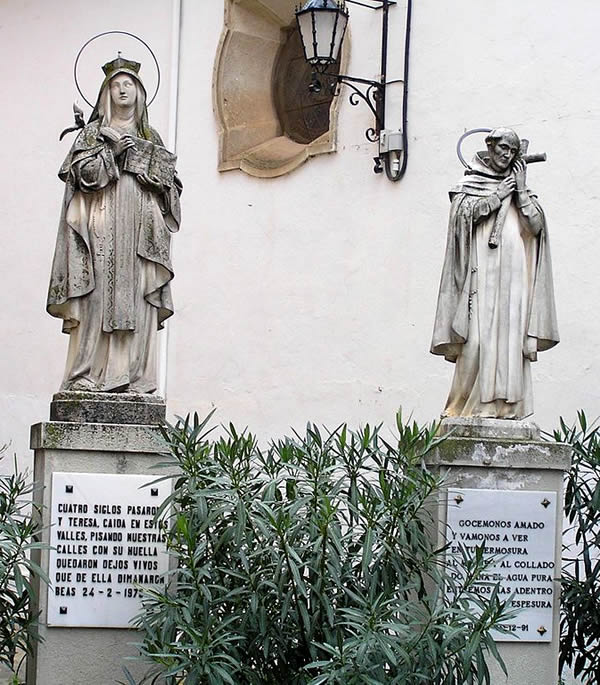 |
| Teresa of Ávila and John of the Cross |
Juan de Yepes y Álvarez, later known as John of the Cross, was born in 1542 in Fontiveros, a small town north of Ávila, Spain. John’s father died when he was three and his mother was left to provide for her three sons, one of whom died in childhood.
From the age of nine to 22, John lived in Medina del Campo, where he was fortunate to have the help of Don Alonso de Toledo, who provided him with a job as an orderly in a hospital and who paid for his studies at the Jesuit school.
In 1563, John entered the Carmelite monastery of Santa Ana in Medina del Campo; from there he was sent to study for the priesthood at the University of Salamanca.
He was an excellent student, yet he always found time to dedicate to prayer and to helping the poor. John was ordained a priest in 1566. A year later, he met Teresa of Ávila and, at her urging, he joined in her efforts to reform the Carmelite order in Spain.
  |
The story of the life of John of the Cross is intertwined with the story of the life of Teresa of Ávila. Teresa was born into a well-to-do family in Ávila, Spain, in 1515. Hers was a generation when the Reconquista Christians threw out Muslim overlords of Spain. It was a time of knights, chivalry, and fierce religious devotion reflected in her own writing and ideals.
She entered the Carmelite Convent of the Incarnation in 1535. After 20 years in the convent, at the age of 39, Teresa experienced a deeper conversion and a desire to return to the primitive Carmelite rule of Mount Carmel. The Carmelite order in Spain had lapsed in the observance of the rule of poverty, prayer, and seclusion lived out by the first hermits. Teresa felt called by God to bring about a reform in the practices of her religious order. She established her first house for nuns in 1562.
She was looking for someone to help her with the reform of the friars when she heard about John. She arranged to meet John in 1567 and convinced him to join her cause. He inaugurated the first house of Discalced (barefoot) friars in Durelo, Spain, in 1568.
The friars adopted the more ascetic and contemplative observance of the primitive rule that involved a very simple lifestyle and many hours of prayer. They made some changes to the rule that allowed them to leave the monastery to preach and to hear the confessions of the nuns. John traveled extensively in his work to reform the order.
The efforts made by Teresa and John to bring about reform were met with mixed response. While many supported their efforts, some were threatened by the changes they were making. John was arrested several times by his own religious brothers. He spent nine months as a prisoner in a six-by-10 room at the monastery of the Carmelite friars in Toledo.
During his imprisonment, John composed some of the poetry for which he would later be famous. After his escape from prison, John was elected superior of the Monastery of Calvario. For the next eight years, he served as superior of various houses of the Discalced friars in Andalusia, traveling extensively in his efforts to support the reform.
In 1589, he left Granada and went to Segovia, where he lived until he became ill in 1591. As a result of the painful medical practices of his day and the scandalous neglect of the prior who held an old grudge against him, John’s condition worsened. He died at the age of 49 in the year 1591. His body was moved in 1603 to Segovia, where it still resides.
Sainthood Declared
John was declared a saint by the Catholic Church in 1726, and he was made a doctor of the church in 1926. He is best known for his poetry and prose reflecting his spiritual wisdom and his profound, very personal relationship with God. His major works are four books that consist of prose commentary on four of his most famous poems: The Ascent of Mount Carmel, The Dark Night, The Spiritual Canticle, and The Living Flame of Love.
The remaining of John’s correspondence with others gives a taste of the personal, affectionate relationship that he had with those he counseled. John was an artist, a mystic, and, above all else, he was a lover of Christ, who lived a life of charity and service to others.
Teresa is most known for her instruction on spirituality and prayer. Her most important works include Interior Castles, The Way of Perfection, Foundations, and her own account of her life. All of the correspondence between John of the Cross and Teresa of Ávila has been lost or destroyed.